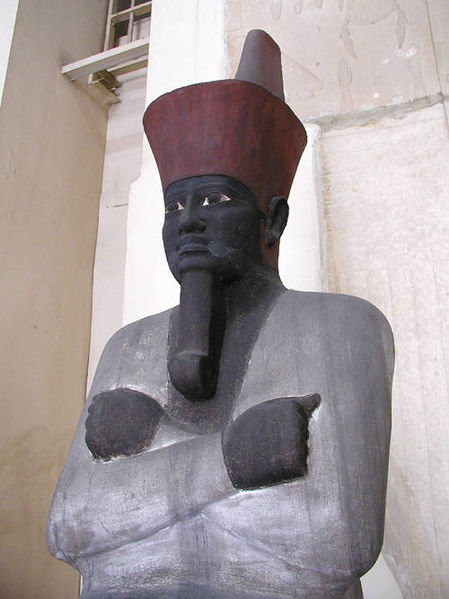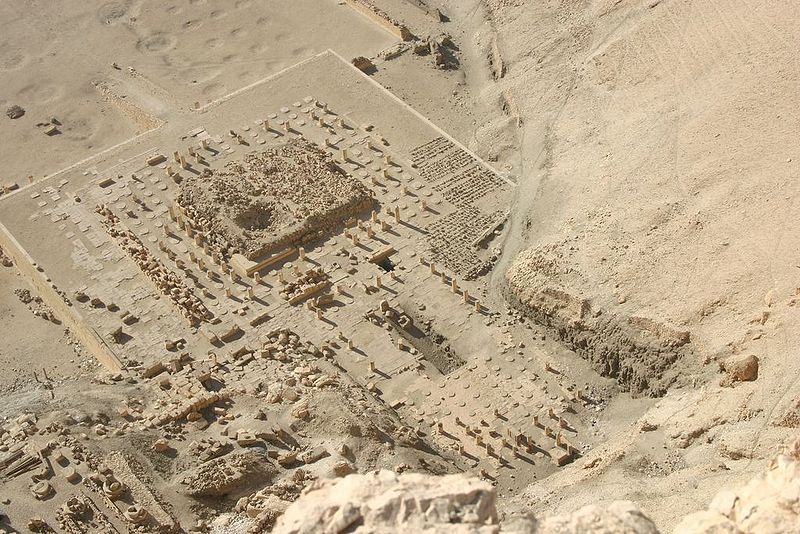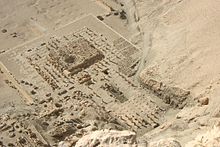Mentuhotep II
De Wikipedia, la enciclopedia libre


Nebhepetra Mentuhotep, o Mentuhotep II, fue el quinto faraón de la dinastía XI de Egipto; gobernó unos cincuenta años, de c. 2046 a 1995 a. C. (von Beckerath) y es considerado por los historiadores el fundador del Imperio Medio de Egipto.
Contenido |
Biografía [editar]
Sucedió a su padre, Intef III. Su nombre de nacimiento era Mentuhotep que significa "MontuNebhepetra "Señor timonel de Ra", aunque durante su mandato cambió en tres ocasiones de titulatura. está satisfecho". Fue coronado como
Emprendió la guerra para unificar bajo su mando todo Egipto, sofocó la revuelta del nomo tinita, depuso al nomarca de Sauty (Asiut), expulsó a los beduinos asiáticos, que intentaban invadir el Delta del Nilo, y convirtió a Uaset (Tebas) en la capital política del reino.
Tras la unificación del país restableció la autoridad real. Emprendió una política de fuerte centralización y dispondrá de un grupo de altos funcionarios, de total confianza, para controlar la administración central y provincial: reapareció el cargo de chaty, el cual dirigía el poder central, y surgió el cargo de Gobernador del Norte, que compartía mando con el Gobernador del Sur y el Gobernador de los desiertos del Este.
Recompenso a los nomarcas fieles, y como fueron respetados por el rey se consideraban verdaderos señores de sus territorios, pues conservaban sus privilegios y seguían actuando con gran autonomía, aunque nominalmente reconocieran al faraón como gobernante absoluto e hijo de Ra.
La situación económica prosperó, sobre todo en el Alto Egipto.
Luchó contra los libios del desierto occidental y contra los nómadas del Sinaí, asegurándose el dominio de la región del Sinaí, y la explotación de sus minas; también reabrió las rutas de caravanas hacia el mar Rojo. Organizó campañas en Nubia hasta la región de Uauat y estableció el control hasta la segunda catarata. Consolidó las fronteras del Delta del Nilo y Nubia.
A su muerte fue enterrado en el templo mausoleo construido en Deir el-Bahari.
En épocas posteriores Mentuhotep fue adorado como un dios en Tebas.
Testimonios de su época [editar]
Mentuhotep prosiguió con los trabajos de restauración en Elefantina, iniciados por Intef III. En Abidos edificó los anexos del templo de Osiris. Embelleció los templos del dios Montu en Tod y Armant.
- Edificaciones
- Templo mausoleo erigido en Deir el-Bahari
- Reconstrucción del templo de Satet en Elefantina
- Edificio del templo en Tod
- Su nombre se ha encontrado grabado en
- Inscripción en una roca, cerca de Asuán (Flinders Petrie)
- Inscripción en una roca, en Shatt er-Rigal (Flinders Petrie)
- Bloques del templo en Nejab (El-Kab)
- Bloques del templo funerario, de Deir El-Bahari (Museo Petrie)
- Bloques de Dendera (Museo Petrie)
Titulatura [editar]
- Al acceder al mando
| Titulatura | Jeroglífico | Transliteración (transcripción) - traducción - (procedencia) |
| Nombre de Horus: |
| s ˁnḫ ib t3uy (Seanjibtauy) El que vivifica el corazón las Dos Tierras (Egipto) (J.J. Clére, J. Vandier, 1948, X, 23) |
| Nombre de Sa-Ra: |
| mn ṯu ḥtp (Mentuhotep) Montu está satisfecho (J.J. Clére, J. Vandier, 1948, X, 23) |
- Después de vencer a los gobernantes tinitas (Abidos)
| Nombre de Horus: |
| nṯr hḏt (Necherhedyet) Divino Señor de la corona Blanca (J.J. Clére, J. Vandier, 1948, X, 27) |
| Nombre de Nebty: |
| nṯr hḏt (Necherhedyet) Divino Señor de la corona Blanca (MDAIK, 1930, 20, 14) |
| Nombre de Nesut-Bity: |
| nb ḥpt rˁ (Nebhepetra) Señor timonel de Ra (J.J. Clére, J. Vandier, 1948, X, 25) |
| Nombre de Sa-Ra: |
| s3 rˁ mn ṯu ḥtp (Sara Mentuhotep) Hijo de Ra, Montu está satisfecho (J.J. Clére, J. Vandier, 1948, X, 23) |
- Después de unificar las Dos Tierras (Egipto)
| Titulatura | Jeroglífico | Transliteración (transcripción) - traducción - (procedencia) |
| Nombre de Horus: |
| sm3 t3uy (Semetauy) El que unifica las Dos Tierras (J.J. Clére, J. Vandier, 1948, X, 28) |
| Nombre de Nebty: |
| sm3 t3uy (Semetauy) El que unifica las Dos Tierras (C. R. Lepsius, 1842, 9) |
| Nombre de Hor-Nub: |
| q3 šuty (Qasuty) Qasuty (BIFAOC, 1901, 9, 1112) |
| Nombre de Nesut-Bity: |
| nb ḥ3pt rˁ (Nebhepetra) Señor timonel de Ra (L R Abidos nº 57) (L R Saqqara nº 46) (Canon de Turín 5.16) |
| Nombre de Sa-Ra: |
| mn ṯ u ḥtp (Mentuhotep) Montu está satisfecho (MDAIK, 1930, 20, 13) |
Referencias [editar]
- Referencias digitales
- http://www.digitalegypt.ucl.ac.uk//chronology/mentuhotepII.html (en inglés)
- Mentuhotep II (en inglés)
Enlaces externos [editar]
 Wikimedia Commons alberga contenido multimedia sobre Mentuhotep II. Commons
Wikimedia Commons alberga contenido multimedia sobre Mentuhotep II. Commons
| Predecesor: Intef III | Faraón Dinastía XI | Sucesor: Mentuhotep III |
Mentuhotep II
From Wikipedia, the free encyclopedia
| Mentuhotep II | |||||
|---|---|---|---|---|---|
 | |||||
| Mentuhotep II | |||||
| Pharaoh of Egypt | |||||
| Reign | 2061–2010 BC, 11th dynasty | ||||
| Predecessor | Intef III | ||||
| Successor | Mentuhotep III | ||||
| Consort(s) | Tem, Neferu, Ashayet, Henhenet, Kawit, Kemsit, Sadeh | ||||
| Children | Mentuhotep III | ||||
| Father | Intef III | ||||
| Mother | Iah | ||||
| Died | 2010 BC | ||||
Nebhepetre Mentuhotep II (2061 BC – 2010 BC) was a Pharaoh of the 11th dynasty, the son of Intef III of Egypt and a minor queen called Iah. His own wife was the 'king's mother' Tem. Other wives were Neferu (his sister) and five women buried in his funerary complex. His only known son was Mentuhotep III.
The king changed his name several times during his reign, perhaps reflecting important political events. His throne name was Nebhepetre, and he was the first ruler of the Middle Kingdom of Egypt. The Turin Canon credits him with a reign of 51 years.[1]
In the 14th year of his reign, an uprising occurred. This was probably connected with the conflict between Mentuhotep II based in Thebes and the rival 10th dynasty based at Herakleopolis Magna.
During his reign, Mentuhotep was able to reunite ancient Egypt for the first time since the 6th dynasty. The exact date when reunification was achieved is not known, but it is assumed to have happened shortly before year 39 of his reign.[3]
Mentuhotep II led military campaigns south into Nubia, which had gained its independence during the First Intermediate Period. There is also evidence of military actions against Palestine. The king reorganized the country and placed a vizier at the head of the administration. The viziers of his reign were Bebi and Dagi. His treasurer was Khety who was involved in organising the sed festival for the king.
Mentuhotep II was buried in a large tomb he had constructed at Deir el-Bahri. Mentuhotep II built temples and chapels at several places in Upper Egypt. These places include Denderah, Abydos, Armant and Gebelein.[4]
Mentuhotep II was considered by his subjects to be half divine, half mortal. This tradition continued under his successors.[citation needed]
[edit] References
- ^ XIth Dynasty
- ^ Clayton, Peter A. Chronicle of the Pharaohs: The Reign-by-Reign Record of the Rulers and Dynasties of Ancient Egypt. Thames & Hudson. p. 72. 2006. ISBN 0-500-28628-0
- ^ Grajetzki, The Middle Kingdom, p. 19
- ^ Grajetzki, The Middle Kingdom, p. 20-21
[edit] Further reading and links
- W. Grajetzki, The Middle Kingdom of Ancient Egypt: History,Archaeology and Society, Duckworth, London 2006 ISBN 0-7156-3435-6, 18-23
- Labib Habachi: King Nebhepetre Menthuhotep: his monuments, place in history, deification and unusual representations in form of gods. Annales du Service des Antiquités de l'Égypte 19 (1963), p. 16-52
- "The Mortuary Temple of Mentuhotep II by Mark Andrews
| Preceded by Intef III | Pharaoh of Egypt Eleventh Dynasty | Succeeded by Mentuhotep III |
| |||||||||||||||||||||||||||||||
related articles
- TT280
- Meketre
- Deir el-Bahri
- Eleventh dynasty of Egypt
- Mentuhotep III
- Intef III
- Amenhotep I
- Mortuary temple
- Senusret III
- Vizier (Ancient Egypt)
En otros idiomas
- العربية
- Català
- Česky
- Deutsch
- English
- Euskara
- Suomi
- Français
- Hrvatski
- Bahasa Indonesia
- Italiano
- 한국어
- Lietuvių
- Nederlands
- Polski
- Português
- Română
- Русский
- Srpskohrvatski / Српскохрватски
- Svenska
- Tiếng Việt
- 中文










![G43 [w] w](http://es.wikipedia.org/w/extensions/wikihiero/img/hiero_G43.png)

![X1 [t] t](http://es.wikipedia.org/w/extensions/wikihiero/img/hiero_X1.png)
![Q3 [p] p](http://es.wikipedia.org/w/extensions/wikihiero/img/hiero_Q3.png)





![V30 [nb] nb](http://es.wikipedia.org/w/extensions/wikihiero/img/hiero_V30.png)


![N35 [n] n](http://es.wikipedia.org/w/extensions/wikihiero/img/hiero_N35.png)
 " alt=">" height="44px">
" alt=">" height="44px">






![N5 [ra] ra](http://en.wikipedia.org/w/extensions/wikihiero/img/hiero_N5.png)
![V30 [nb] nb](http://en.wikipedia.org/w/extensions/wikihiero/img/hiero_V30.png)
![Aa5 [Hp] Hp](http://en.wikipedia.org/w/extensions/wikihiero/img/hiero_Aa5.png)

![Y5 [mn] mn](http://en.wikipedia.org/w/extensions/wikihiero/img/hiero_Y5.png)
![N35 [n] n](http://en.wikipedia.org/w/extensions/wikihiero/img/hiero_N35.png)
![V13 [T] T](http://en.wikipedia.org/w/extensions/wikihiero/img/hiero_V13.png)
![G43 [w] w](http://en.wikipedia.org/w/extensions/wikihiero/img/hiero_G43.png)
![R4 [Htp] Htp](http://en.wikipedia.org/w/extensions/wikihiero/img/hiero_R4.png)
![X1 [t] t](http://en.wikipedia.org/w/extensions/wikihiero/img/hiero_X1.png)
![Q3 [p] p](http://en.wikipedia.org/w/extensions/wikihiero/img/hiero_Q3.png)



No hay comentarios:
Publicar un comentario